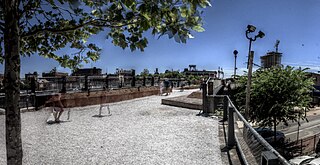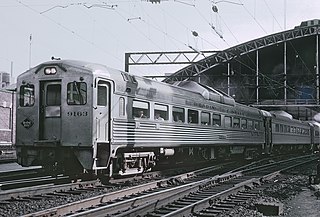
The Reading Company was a Philadelphia-headquartered railroad that provided passenger and freight transport in eastern Pennsylvania and neighboring states that operated from 1924 until its acquisition by Conrail in 1976.

The SEPTA Regional Rail system is a commuter rail network owned by SEPTA and serving the Philadelphia metropolitan area. The system has 13 branches and more than 150 active stations in Philadelphia, Pennsylvania, its suburbs and satellite towns and cities. It is the sixth-busiest commuter railroad in the United States, and the busiest outside of the New York, Chicago, and Boston metropolitan areas. In 2016, the Regional Rail system had an average of 132,000 daily riders and 118,800 daily riders as of 2019.

The Reading Viaduct, also called The Rail Park, is a disused elevated rail line in the Callowhill district of Philadelphia, Pennsylvania, United States that has been partly transformed into a rail trail.
Schuylkill River Passenger Rail is a proposed passenger train service along the Schuylkill River between Philadelphia and Reading, Pennsylvania, with intermediate stops in Norristown, King of Prussia, Phoenixville, and Pottstown.

The SEPTA Main Line is the section of the SEPTA Regional Rail system from the Zoo Interlocking in West Philadelphia to Lansdale Station in Lansdale, Pennsylvania. The line is 26.25 miles (42.25 km) long, and serves all 13 SEPTA Regional Rail lines.

Wayne Junction station is a SEPTA Regional Rail junction station located at 4481 Wayne Avenue, extending along Windrim Avenue to Germantown Avenue. The station is located in the Nicetown neighborhood of Philadelphia. Wayne Junction serves as a multi-modal transfer point between six of SEPTA's regional rail lines as well as three major transit routes – the Route 75 Trackless Trolley and the Route 23 and 53 bus lines. The station served more than 321,000 riders annually in 2018.
The North Pennsylvania Railroad was a railroad company which served Philadelphia, Montgomery County, Bucks County and Northampton County in Pennsylvania. It was formed in 1852, and began operation in 1855. The Philadelphia and Reading Railway, predecessor to the Reading Company, leased the North Pennsylvania in 1879. Its tracks were transferred to Conrail and the Southeastern Pennsylvania Transportation Authority (SEPTA) in 1976.

The Schuylkill Branch was a rail line owned and operated by the former Pennsylvania Railroad (PRR) in Pennsylvania. The line ran from the Philadelphia to Harrisburg Main Line at 52nd Street in Philadelphia north via Norristown, Reading, and Pottsville to Delano Junction, about 2.5 mi (4.0 km) northeast of Delano. From Delano Junction, the PRR had trackage rights over the Lehigh Valley Railroad's Hazleton Branch and Tomhicken Branch to Tomhicken, where the PRR's Catawissa Branch began.

The Chestnut Hill East Line is a route of the SEPTA Regional Rail system. The route serves the northwestern section of Philadelphia with service to Germantown, Mount Airy, and Chestnut Hill. It is one of two lines that serve Chestnut Hill, the other one being the Chestnut Hill West Line. The line is fully grade-separated.

The Philadelphia, Germantown and Norristown Railroad (PG&N) was a railway company in the United States. It was incorporated in 1831 and opened its first line in 1832, making it one of the oldest railroads in North America. The Philadelphia and Reading Railroad, a forerunner of the Reading Company, leased the company's lines in 1870, ending its period of independent operation. Its lines are currently part of the SEPTA Regional Rail network in the Philadelphia region.

Shawmont is a former train station in Philadelphia, Pennsylvania. It is located on Nixon Street in the Roxborough section of Lower Northwest Philadelphia. Built by the Philadelphia, Germantown and Norristown Railroad, it later became part of the Reading Railroad and ultimately SEPTA Regional Rail's R6 Norristown Line. SEPTA made the station a whistle stop and closed its waiting room in 1991. SEPTA later closed the station in 1996. In 2018, $1 million was set aside for repairs and rehabilitation.

The New York Branch or the Bound Brook Route was a railway line in Pennsylvania and New Jersey. It was operated by the Reading Company and owned by two of its subsidiaries, the North Pennsylvania Railroad and the Delaware and Bound Brook Railroad. It formed part of the Reading's route from Philadelphia to New York City, used by the famed Crusader. The line was transferred to Conrail in 1976 and was split into the Neshaminy Line and Trenton Line. SEPTA continues to operate commuter trains to West Trenton as part of its West Trenton Line.
The Stony Creek Branch is a railway line in Montgomery County, Pennsylvania. It runs 9.9 miles (15.9 km) from Lansdale, Pennsylvania, to Norristown, Pennsylvania, connecting the Bethlehem and Doylestown Branches with the Norristown Branch. Although SEPTA owns the line, it is freight-only. CSX Transportation, Norfolk Southern Railway, and the Pennsylvania Northeastern Railroad have trackage rights on the branch.

The Norristown Branch is a railway line in Pennsylvania. It runs 14.6 miles (23.5 km) from a junction with the SEPTA Main Line in North Philadelphia to Norristown, Pennsylvania. It was originally built by the Philadelphia, Germantown and Norristown Railroad (PG&N) in 1834, and was a part of the Reading Company system from 1870 until 1976. Today it is owned by SEPTA and hosts the Manayunk/Norristown Line commuter rail service.

The Reading electric multiple units were a fleet of electric multiple units operated by the Reading Company on its Philadelphia commuter rail lines. The majority were constructed by Bethlehem Steel in 1931–1933; American Car and Foundry delivered additional cars in 1949. Some cars, rebuilt in 1964–1965 and christened "Blueliners", remained in service with Conrail and later the SEPTA until 1990. Several have been preserved.
The Main Line of the Reading Company was a railway line in the U.S. state of Pennsylvania. The 88-mile-long (142 km) main line ran from Philadelphia to Pottsville, Pennsylvania, following the Schuylkill River. Following the Reading's bankruptcy in the 1970s the line was conveyed to Conrail. The physical line continues to exist but is no longer administered as a single unit. Conrail split the line, combining the section from Philadelphia to Reading with the Lebanon Valley Branch to form the Harrisburg Line. The section north of Reading was designated the Pottsville Branch; Conrail later sold most of the branch to the Reading Blue Mountain and Northern Railroad.
The Chestnut Hill East Branch is a railway line in Pennsylvania. It runs 5.5 miles (8.9 km) from a junction with the SEPTA Main Line in Nicetown–Tioga, a neighborhood in Philadelphia, to Chestnut Hill, Philadelphia. The oldest part of it was built in 1832 by the Philadelphia, Germantown and Norristown Railroad. It was part of the Reading Company system from 1870 until 1976. Today it is owned by SEPTA and hosts the Chestnut Hill East Line commuter rail service. The line runs roughly parallel to the Chestnut Hill West Branch, formerly of the Pennsylvania Railroad.
The Fox Chase Branch, formerly the Newtown Branch, is a railway line in the state of Pennsylvania. It runs 4.9 miles (7.9 km) from a junction with the SEPTA Main Line near Wayne Junction to Fox Chase. At its fullest extent, it continued another fifteen miles north to Newtown. The oldest part of it was built in 1876 by the Philadelphia, Newtown and New York Railroad. It was part of the Reading Company system from 1879 until 1976. Today it is owned by SEPTA and hosts the Fox Chase Line commuter rail service.
The New York Short Line was a railway line in Pennsylvania. It was operated by the Reading Company and built by the New York Short Line Railroad, a subsidiary. It was opened in 1906 to provide a more direct route between Philadelphia and New York City, bypassing the existing route via Jenkintown. The line was conveyed to Conrail in 1976 and is now part of the Trenton Subdivision of CSX.

The Pottsville line was a commuter rail service in the Delaware Valley, connecting Pottsville, Reading, and Pottstown with Philadelphia. It was the last vestige of passenger service on the former Reading main line. The service lasted into the SEPTA era and was discontinued in 1981. SEPTA continues to operate Manayunk/Norristown Line commuter trains between Philadelphia and Norristown.















